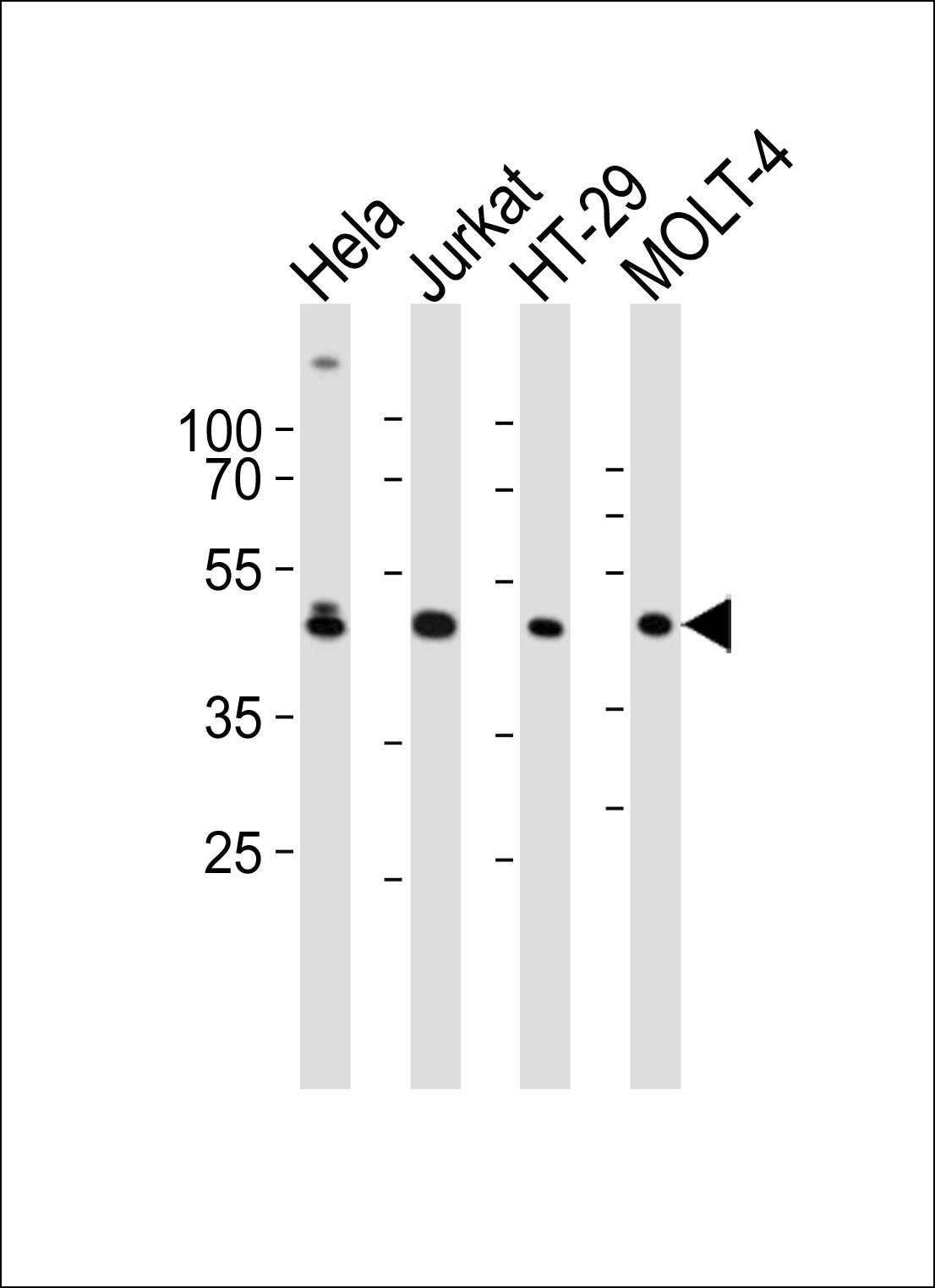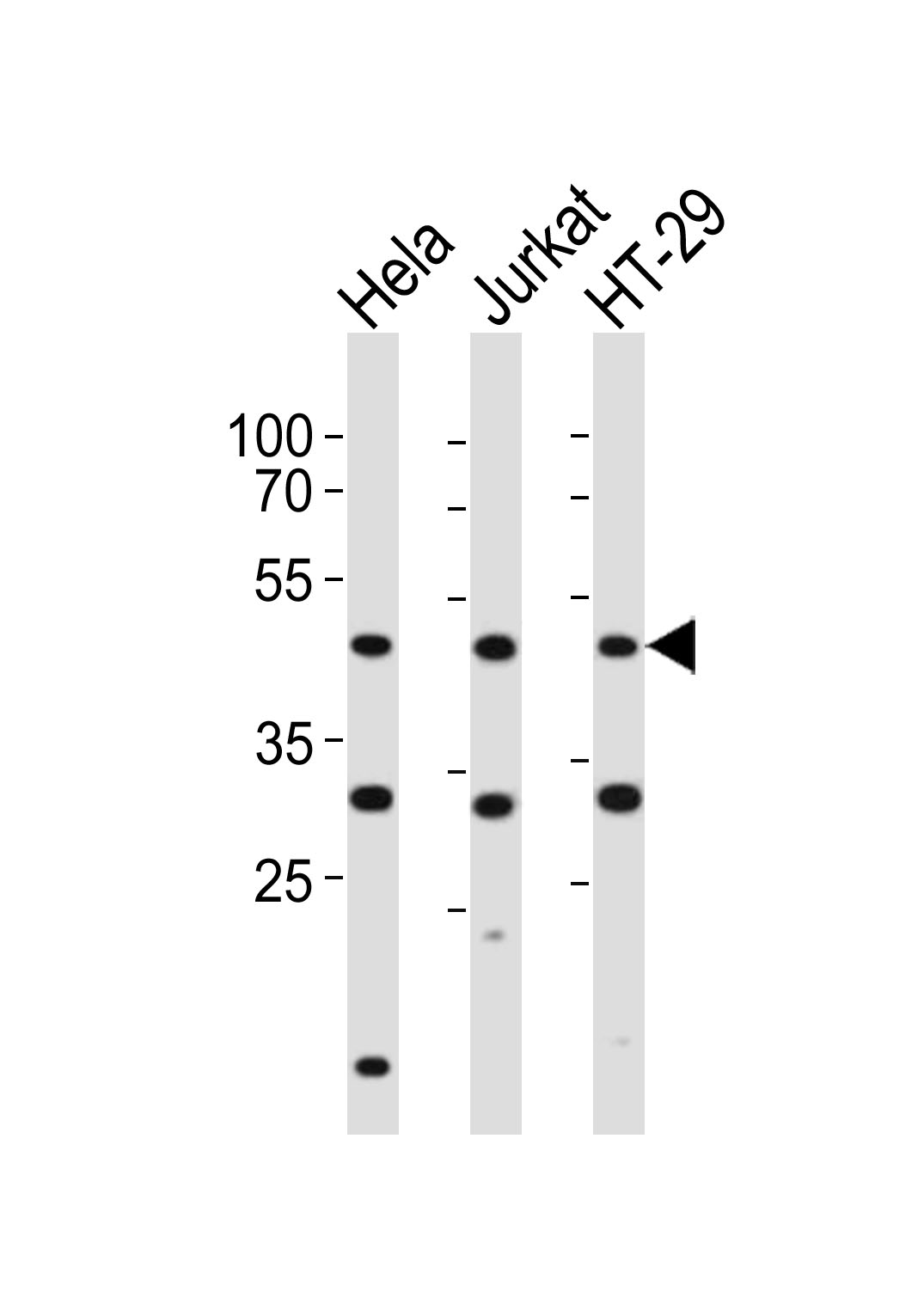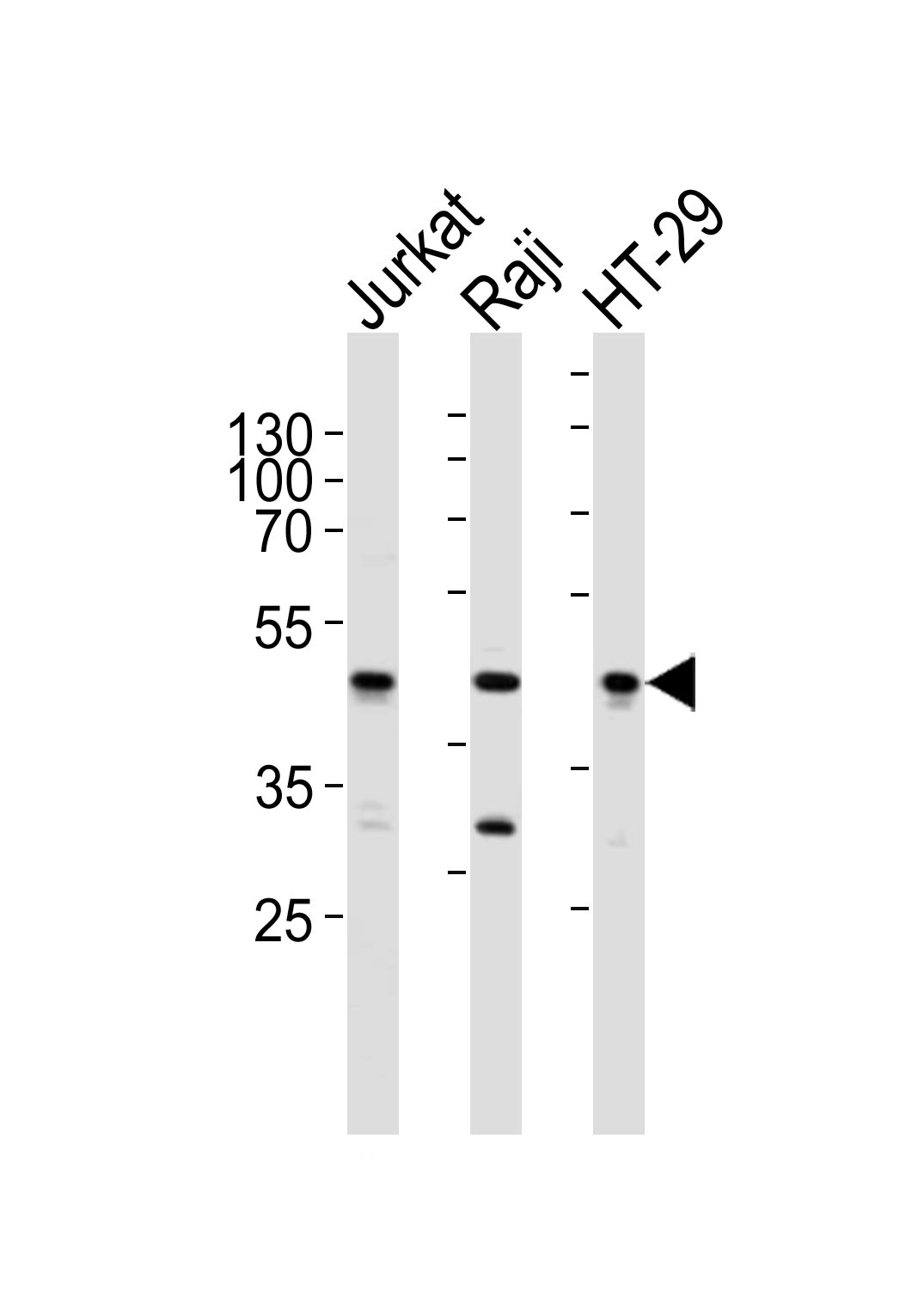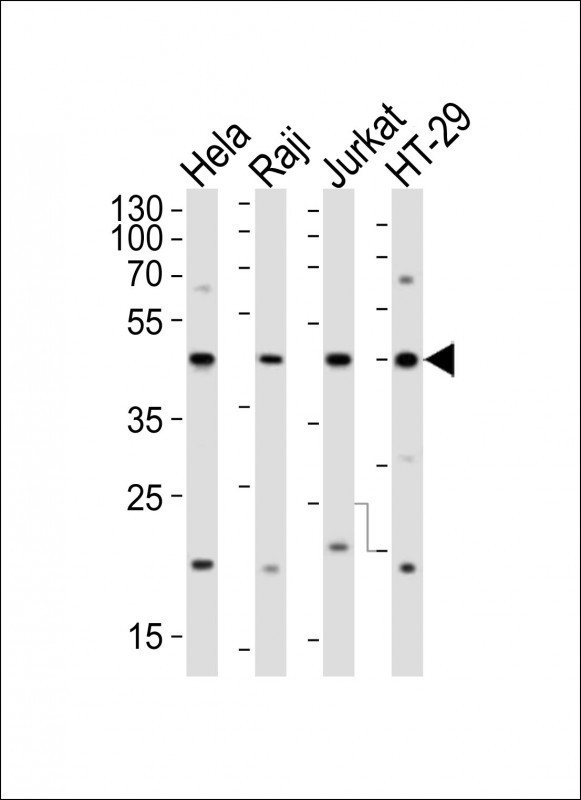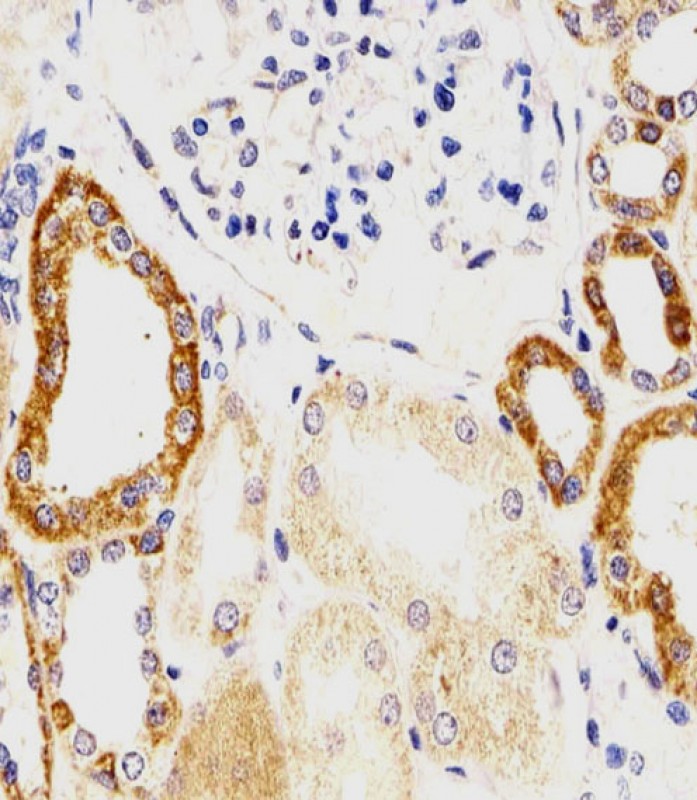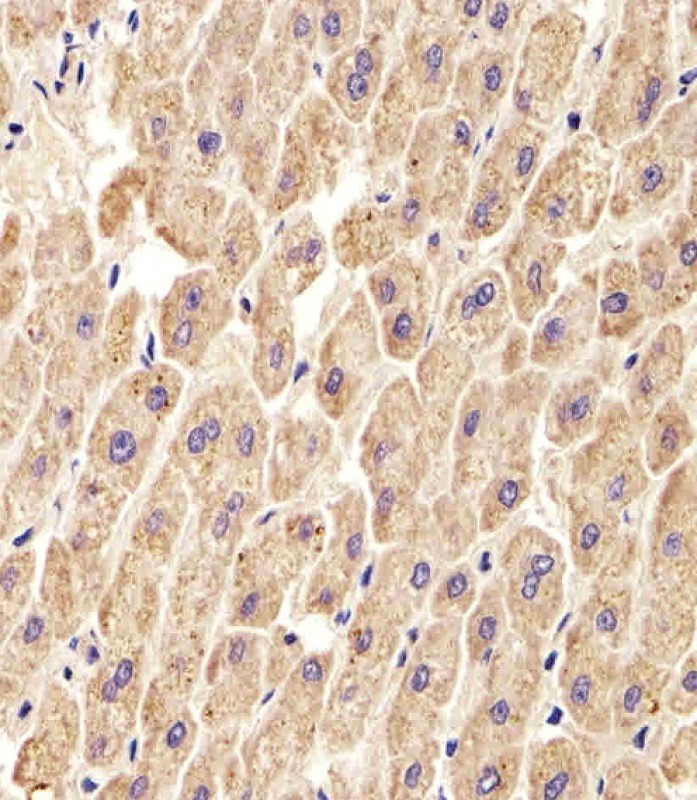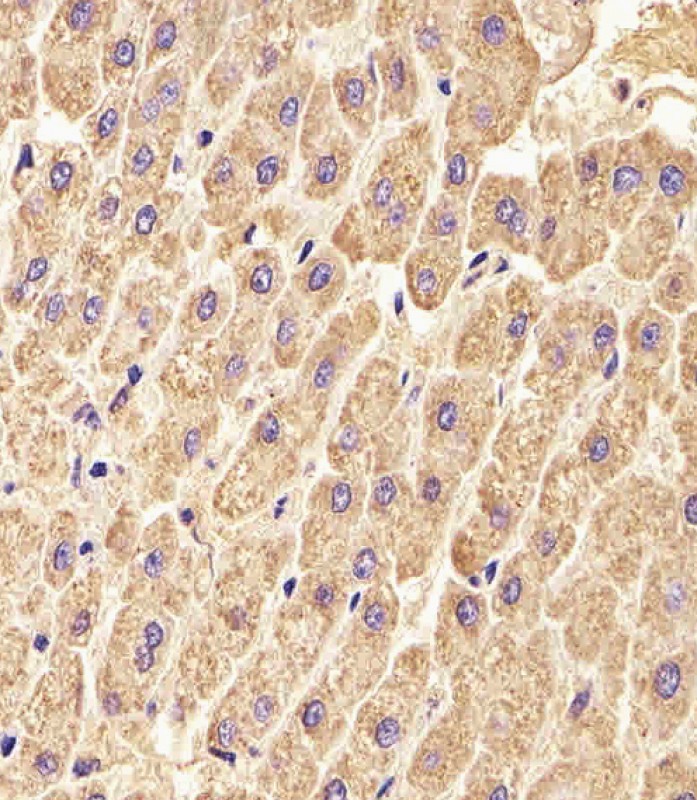GLUL Antibody (N-term)
Affinity Purified Rabbit Polyclonal Antibody (Pab)
- SPECIFICATION
- CITATIONS
- PROTOCOLS
- BACKGROUND

Application
| WB, IHC-P, E |
|---|---|
| Primary Accession | P15104 |
| Other Accession | P46410, P15105, Q4R7U3, P16580, P15103 |
| Reactivity | Human, Mouse |
| Predicted | Bovine, Chicken, Monkey, Pig |
| Host | Rabbit |
| Clonality | Polyclonal |
| Isotype | Rabbit IgG |
| Calculated MW | 42064 Da |
| Antigen Region | 70-96 aa |
| Gene ID | 2752 |
|---|---|
| Other Names | Glutamine synthetase, GS, Glutamate decarboxylase, Glutamate--ammonia ligase, GLUL, GLNS |
| Target/Specificity | This GLUL antibody is generated from rabbits immunized with a KLH conjugated synthetic peptide between 70-96 amino acids from the N-terminal region of human GLUL. |
| Dilution | WB~~1:2000 IHC-P~~1:10~50 |
| Format | Purified polyclonal antibody supplied in PBS with 0.09% (W/V) sodium azide. This antibody is purified through a protein A column, followed by peptide affinity purification. |
| Storage | Maintain refrigerated at 2-8°C for up to 2 weeks. For long term storage store at -20°C in small aliquots to prevent freeze-thaw cycles. |
| Precautions | GLUL Antibody (N-term) is for research use only and not for use in diagnostic or therapeutic procedures. |
| Name | GLUL {ECO:0000303|PubMed:30158707, ECO:0000312|HGNC:HGNC:4341} |
|---|---|
| Function | Glutamine synthetase that catalyzes the ATP-dependent conversion of glutamate and ammonia to glutamine (PubMed:16267323, PubMed:30158707, PubMed:36289327). Its role depends on tissue localization: in the brain, it regulates the levels of toxic ammonia and converts neurotoxic glutamate to harmless glutamine, whereas in the liver, it is one of the enzymes responsible for the removal of ammonia (By similarity). Essential for proliferation of fetal skin fibroblasts (PubMed:18662667). Independently of its glutamine synthetase activity, required for endothelial cell migration during vascular development: acts by regulating membrane localization and activation of the GTPase RHOJ, possibly by promoting RHOJ palmitoylation (PubMed:30158707). May act as a palmitoyltransferase for RHOJ: able to autopalmitoylate and then transfer the palmitoyl group to RHOJ (PubMed:30158707). Plays a role in ribosomal 40S subunit biogenesis (PubMed:26711351). Through the interaction with BEST2, inhibits BEST2 channel activity by affecting the gating at the aperture in the absence of intracellular L-glutamate, but sensitizes BEST2 to intracellular L-glutamate, which promotes the opening of BEST2 and thus relieves its inhibitory effect on BEST2 (PubMed:36289327). |
| Cellular Location | Cytoplasm, cytosol. Microsome {ECO:0000250|UniProtKB:P09606} Mitochondrion {ECO:0000250|UniProtKB:P09606}. Cell membrane; Lipid-anchor. Note=Mainly localizes in the cytosol, with a fraction associated with the cell membrane |
| Tissue Location | Expressed in endothelial cells. |

Thousands of laboratories across the world have published research that depended on the performance of antibodies from Abcepta to advance their research. Check out links to articles that cite our products in major peer-reviewed journals, organized by research category.
info@abcepta.com, and receive a free "I Love Antibodies" mug.
Provided below are standard protocols that you may find useful for product applications.
Background
GLUL belongs to the glutamine synthetase family. It catalyzes the synthesis of glutamine from glutamate and ammonia. Glutamine is a main source of energy and is involved in cell proliferation, inhibition of apoptosis, and cell signaling.
References
Di Tommaso,L., et.al., J. Hepatol. 50 (4), 746-754 (2009)
If you have used an Abcepta product and would like to share how it has performed, please click on the "Submit Review" button and provide the requested information. Our staff will examine and post your review and contact you if needed.
If you have any additional inquiries please email technical services at tech@abcepta.com.













 Foundational characteristics of cancer include proliferation, angiogenesis, migration, evasion of apoptosis, and cellular immortality. Find key markers for these cellular processes and antibodies to detect them.
Foundational characteristics of cancer include proliferation, angiogenesis, migration, evasion of apoptosis, and cellular immortality. Find key markers for these cellular processes and antibodies to detect them. The SUMOplot™ Analysis Program predicts and scores sumoylation sites in your protein. SUMOylation is a post-translational modification involved in various cellular processes, such as nuclear-cytosolic transport, transcriptional regulation, apoptosis, protein stability, response to stress, and progression through the cell cycle.
The SUMOplot™ Analysis Program predicts and scores sumoylation sites in your protein. SUMOylation is a post-translational modification involved in various cellular processes, such as nuclear-cytosolic transport, transcriptional regulation, apoptosis, protein stability, response to stress, and progression through the cell cycle. The Autophagy Receptor Motif Plotter predicts and scores autophagy receptor binding sites in your protein. Identifying proteins connected to this pathway is critical to understanding the role of autophagy in physiological as well as pathological processes such as development, differentiation, neurodegenerative diseases, stress, infection, and cancer.
The Autophagy Receptor Motif Plotter predicts and scores autophagy receptor binding sites in your protein. Identifying proteins connected to this pathway is critical to understanding the role of autophagy in physiological as well as pathological processes such as development, differentiation, neurodegenerative diseases, stress, infection, and cancer.

